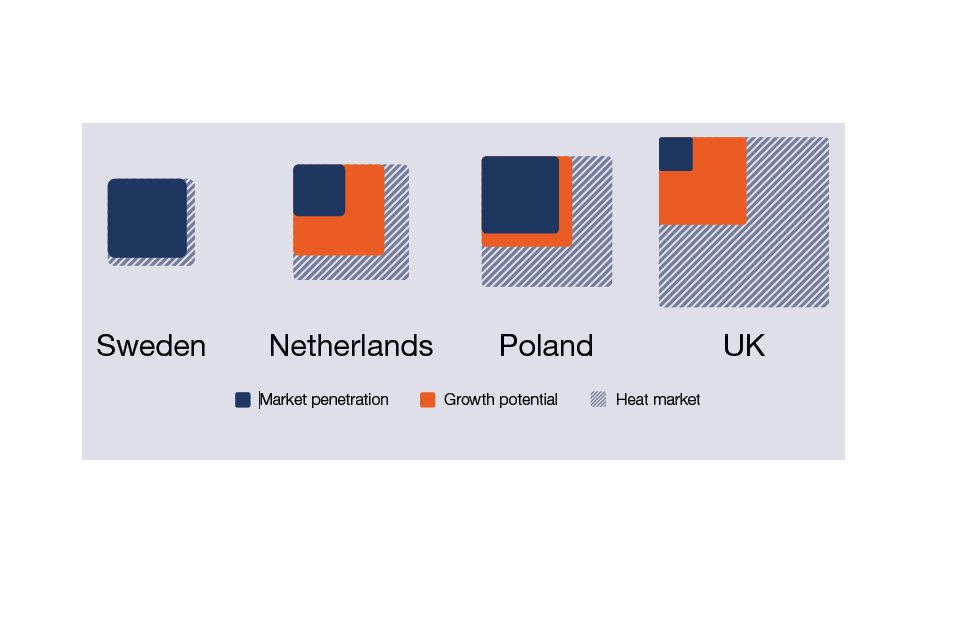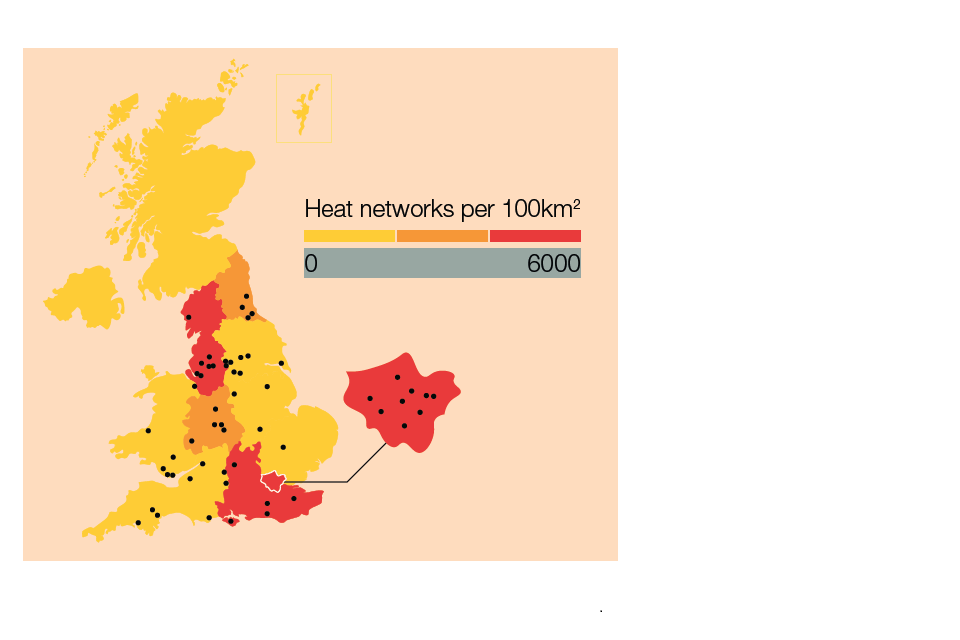UK heat networks: market overview (accessible webpage)
Updated 25 July 2024
Opportunities offered by heat networks
The UK is working toward a strong, resilient and zero carbon economy; heat networks offer more opportunities on this journey.
What is a heat network?
Heat networks distribute heat or cooling from centralised sources to a variety of different customers, such as public buildings, shops, offices, hospitals, universities and homes. Whether they are supplying a few neighbouring buildings or entire cities, these highly efficient systems remove the need for individual boilers or heaters in each building connected.
Inherently flexible, heat networks can take advantage of a wide array of different heat sources – including the recovery of low-carbon heat from resources that would otherwise be wasted – such as industry, energy-from-waste plants, or naturally-occurring sources such as geothermal or rivers.
A growing sector
Investing in local heat and energy networks is a vital part of the transition to net zero by 2050. Local authorities have been declaring climate emergencies and looking for ways to decarbonise quickly and at scale. Heat networks can be a cost-effective way to reduce carbon emissions from heating and hot water. And as they expand, their carbon-saving potential increases – also enabling more sources of waste heat to be utilised. The sector needs to further accelerate its growth and this is an opportunity for you to enter an expanding market and help shape the future of UK energy.
How big is the opportunity?
Heat in buildings is one of the biggest sources of UK emissions. There is an urgent need to decarbonise, make change and transform heating supplies – now.
UK emissions sources
The UK’s emissions are in total 468 MtCO2e, of which:
- heat 37%
- space heating (and cooling) 17%
- industrial heat 14%
- hot water 4%
- cooking 2%
- transport 27%
- building and industry (non-heat) 16%
- land use, land-use change, and forestry (LULUCF), agriculture and waste 11%
- other 8%
The focus areas for heat networks are space heating and cooling, and hot water.
Why get involved in UK heat networks?
Gas has played a vital role in helping reduce our carbon emissions by 38% since 1990. In our transition to zero carbon it will need to be replaced with low carbon heat across the economy.
The UK consistently tops global rankings as the best place to invest and do business. Heat network investment potential is estimated to be £60 billion to £80 billion by 2050.
The UK government is creating a market framework to protect consumers, encourage low-carbon development, and promote investment. Government is also working with the Heat Networks Industry Council and trade associations to build a competitive and innovative UK market that delivers and sustains jobs, exports and economic benefits.
Heat network zoning is core to this growth and when launched in 2025, it will fundamentally transform the development of heat networks in towns and cities across England. Using new legislation under the Energy Act 2023, local communities will be empowered to accelerate the development of heat networks in their area.
Comparison of heat network capacity growth potential
Estimated growth potential of installed district heating capacity in a Heat Road Map Europe 2050 scenario

National heat market
Current market share vs future market share (%)in the Climate Change Committee, Net zero scenario
Of the total heat market:
- in 2022 it is less than 3% market share
- in 2050 it will be 20% market share
Existing networks and planned projects
Number of heat networks by region and type (in 2021)

Estimated annual heat network growth
Ambition: increase heat from networks to 20% - graph showing steady growth and high growth scenarios

Areas of opportunity
There are opportunities across all areas of heat network growth. From alleviating fuel poverty to zero carbon targets, you can help us move the sector forward.
1. Environment
Drive clean energy innovation towards:
- achieving net zero carbon by 2050
- improving air quality
- increasing resource efficiency
2. Innovation
Lead the way in:
- smart heating
- using big data
- linking into wider energy systems
3. Infrastructure
Play a critical part in:
- constructing large scale, high-value projects
- creating long-term assets
- using industrial and waste heat
4. Finance and investment
Join a growing market with access to:
- government support
- positive return on investment
- future revenue opportunities
5. Society
Create wider positive change by:
- developing local regeneration areas
- creating jobs
- improving health and wellbeing
The current picture
Change is underway: government is supporting heat network market growth with over half a billion pounds in investment.
Near-term investment pipeline of heat network projects and their current stages of development
Total project capital expenditure (capex) in millions.
- Heat Networks Delivery Unit (HNDU)-supported development projects - £1,151 million
- projects being supported by grant funding from the Green Heat Network Fund (GHNF) - £1,240 million
- projects being supported by grant funding from Heat Networks Investment Project (HNIP)
- heat mapping and masterplanning (complete) £40 million
Government funding support
- Heat Network Efficiency Scheme (HNES) - £77 million
- HNDU - £37 million
- HNIP - £320 million
- GHNF - more than £268 million (£485 million of additional funding for the scheme was announced in December 2023)
Growing number of people in government focusing on heat networks
- 2022+ - 60
- 2017 - 30
- 2013 - 15
- 2012 - 5
Case study of heat networks being built across the UK
Examples of projects that have been developed with the support of the government’s HNDU and HNIP capital support (2023 figures).
Liverpool Waters Heat Network
- Grant - £7.6 million
- Heat - 41 GWh / yr
- CO2 - 4,200 tonnes / year (when completed)
- Size - 9,000 homes plus commercial space
Bristol Heat Network
- Grant - £22.5 million
- Heat - 14.9 GWh / yr
- CO2 - 968 tonnes / year
- Size - 19 buildings (mixed use), 2,080 homes
Gateshead District Energy Scheme
- Grant - £8.6 million
- Heat - 15 GWh / yr
- CO2 - 1,933 tonnes / year
- Size - 13 buildings, 350 homes
London Meridian Water Heat Network
- Grant - £17 million
- Heat - 122 GWh / yr (when completed)
- CO2 - 25,000 tonnes / year (when completed)
- Size - 20 commercial buildings (by 2025), 10,000 homes (by 2030)
The 2050 vision
We are committed to creating the market conditions to accelerate deployment of reliable, decarbonised heating and cooling networks, enabling us to unlock the sector’s potential and achieving our net zero commitments.
% of heat from heat networks
Relative to existing size of heat market
- 2024 - 3%
- 2050 - 20%
Potential investment
(estimated by the Heat Networks Industry Council)
- up to £80 billion
Unlock diverse energy sources
- ocean and river source heat pumps
- waste industrial / commercial heat, such as data centres
- solar thermal - ground mounted with pit storage
- deep geothermal hear
- large-scale heat pumps
- energy from waste - heat and electricity from incineration
Supplied terawatt-hours (TWh)
Estimated increase:
- 2020 - 12.9 TWh
- 2050 - 95 TWh
Estimated CO2 savings
(estimated by the Heat Networks Industry Council)
- 2020 - 1.4 Mtonnes
- 2050 - 15 Mtonnes
Are you ready?
Be part of the future of UK energy:
- decide your role in the UK heat networks market
- develop your market offer
- get started with DBT support: www.great.gov.uk/international/invest
- bring your offer to market
Contact heatnetworks@energysecurity.gov.uk
Sources
- Clean Growth, Transforming Heating, 2018
- Committee on Climate Change, Net Zero: The UK’s Contribution to Stopping Global Warming, 2019
- Department for Business, Energy and Industrial Strategy, Clean Growth Strategy, 2018
- Department for Business, Energy and Industrial Strategy, Energy Trends: Experimental Statistics on Heat Networks, 2018
- Department for Business, Energy and Industrial Strategy, Opportunity areas for district heating networks in the UK: second National Comprehensive Assessment, 2021
- Element Energy, Research on District Heating and Local Approaches to Heat Decarbonisation, 2015
- Heat Networks Project Pipeline: January to March 2020 Heat Roadmap Europe 4 2018
- Institute for Public Policy Research, Piping Hot: The Opportunity for Heat Networks in a New Industrial Strategy, 2017
Please note that all facts and figures quoted in this brochure were correct at the time of publication (2024).
